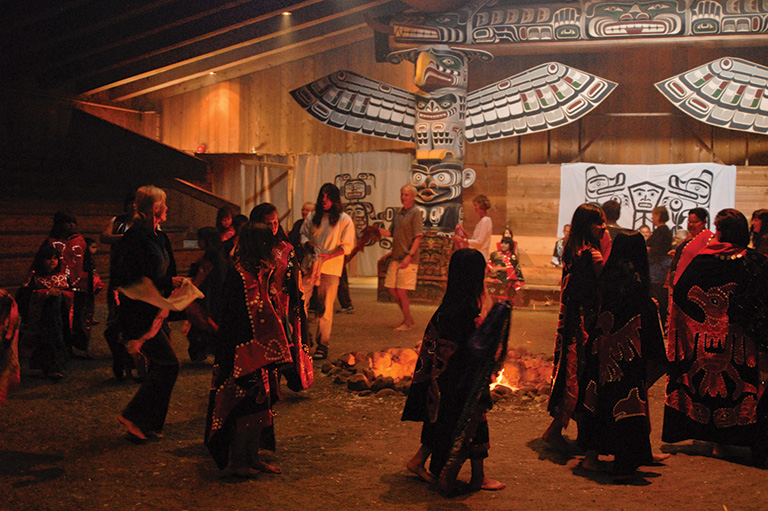Cultured Cruising

Refurbished in nautical splendour, with gleaming brass and mahogany trim, the old hospital yacht Columbia III sails again. Only now it is a tour boat for Mothership Adventures, taking passengers through the wild and rugged islands in British Columbia’s Broughton Archipelago.
We were two of ten guests on board — a mother-and-daughter team, both ready for our cruise with culture.
Orienting ourselves on our little ship we met Ross Campbell, the captain, who kept us afloat and entertained us with stories of coastal life. His wife Fern and their daughter Miray did everything else to make sure we were comfortable. This included three gourmet meals and fresh cookies emerging daily from a very small galley.
Lillian Hunt of the Namgis First Nation brought the history and culture of the Kwakwaka’wakw to life as we plied the waters of Queen Charlotte Strait between the mainland and the northern portion of Vancouver Island.
Our first day of discovery began at the U’mista Cultural Centre in Alert Bay, a small community of about 550 people on Cormorant Island. The modern, cedar-lined log building sits beside a worn and deserted three-storey former residential school. At the centre we discovered the unhappy history behind the Kwakwaka’wakw’s unique collection of ancient potlatch masks and regalia.
The sorry tale begins in the late nineteenth century, when a federal government Indian agent was pressed by missionary groups and ruled that potlatch ceremonies were pagan and therefore must be banned. All ceremonial family masks and regalia were to be seized.
Eventually, many of these items ended up in the hands of museums and private collectors around the world. It was a terrible cultural loss for the Kwakwaka’wakw people.
Outside the centre, there are beautifully carved totem poles, which are a visible form of the history of the people. “In our culture, everything goes back to the earth,” Hunt explains. The totem poles — worn by time and by the elements — illustrate the triumphs and tragedies of past generations.
The presence of the former residential school is a continuing reminder of the tragedy that saw children from across Canada taken from their families and deprived of their Indigenous culture. Thanks to the efforts of dedicated community members, “we are relearning our heritage,” Hunt says.

Inside the U’mista Centre are several magnificent masks recovered from the Canadian Museum of Civilization (now Canadian Museum of History) in Ottawa — stylized owls, wolves, and ghostly faces with bulging black eyes and cedar strips for hair. Each series of masks tells the story of births, marriages, deaths, hunts, and trophies.
Hunt leads visitors to the local big house just up the road from the U’mista Centre.
The big house is a great cedar hall reminiscent of an original tribal big house, with a stage at one end. Sitting on bleacher-style seats, we watch local residents — costumed and masked — performing traditional potlatch dances. Swept up by the drumming, chants, and rhythms, we joined the dancers.
Each morning during the visit, we left the Columbia III by Zodiac to explore the scenery and culture of the surrounding area. One day we viewed an ancient chief’s burial box on top of a tree. Another day, we headed to a midden, a white wall of clamshells that had been discarded over the centuries.
We also explored a deserted village. A highlight was seeing an old school. Half-hidden behind a mass of huckleberry bushes, its roof covered in moss, the school now sits rotting in the heavy rainforest.
We also cherished our time spent aboard the Columbia III. We kept our cameras at the ready, photographing everything from mist-shrouded mountains, to leaping and diving white-bellied dolphins, to blazing orange sunsets.
The meals were fresh — often just out of the oven — and cooked to perfection. Ross and Fern Campbell enthralled us with their stories of life in this remote and beautiful region.
Each night, we were lulled to sleep in our pocket-sized cabins by the fresh ocean breeze. On our trim little yacht, sailing among the unspoiled and rugged islands of British Columbia, it truly was a magical — and historical — vacation.
Themes associated with this article
Advertisement




